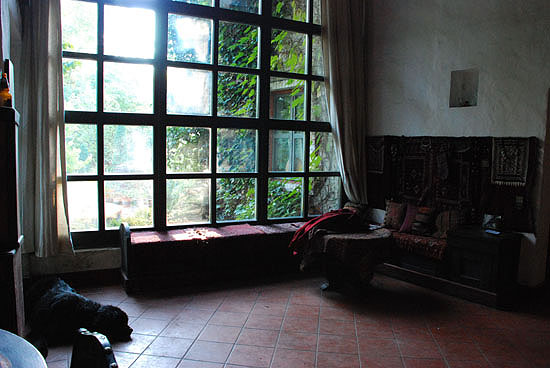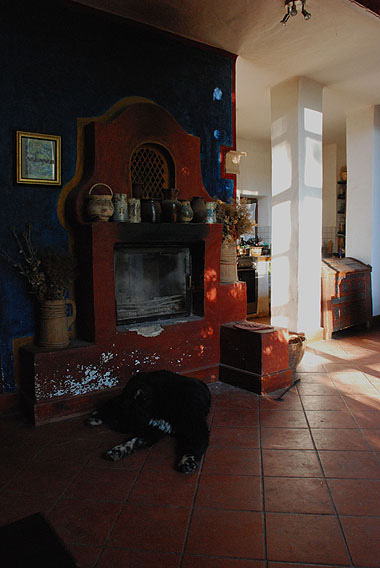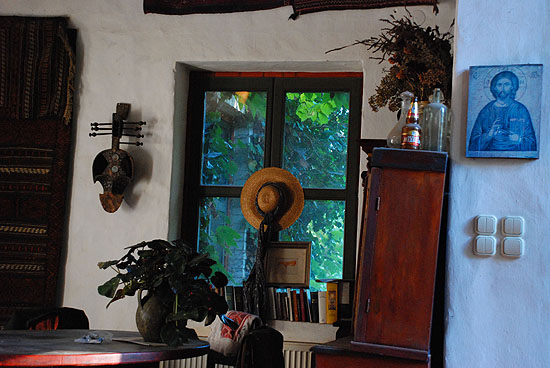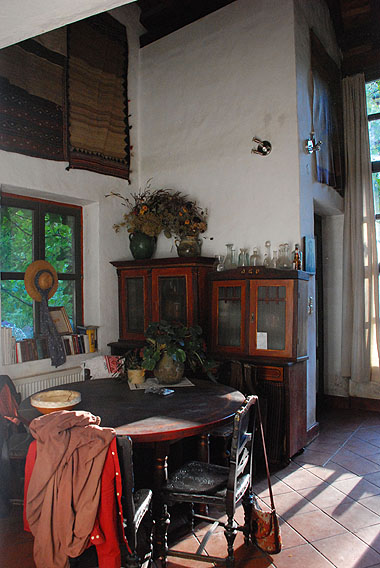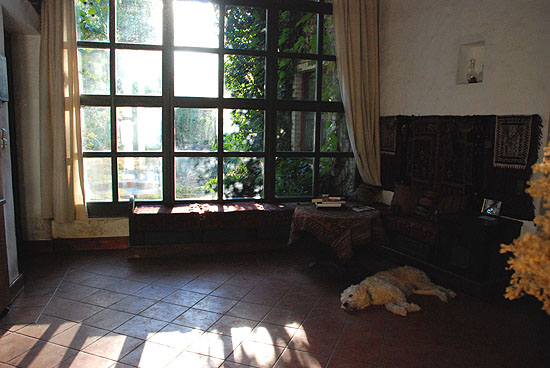 “Respect only what brings joy, energy and purpose into your life.
“Respect only what brings joy, energy and purpose into your life.Then follow your way, the way of magic and dream.”
„Hypnotherapy and relaxation technics are attractive primarily to those clients
who are looking for trance experiences.”
(quotations from sites of psychologists
recommended on pszichologia.lap.hu)
As a Christian psychologist, for a couple of years I have pursued a therapy which integrates the tradition of Christian spiritual guidance with the knowledge of modern psychology. In this September I have included a description of it (at the moment in Hungarian only) on my page, and startlap.hu link portal.
I have sent it as a recommended link to a dozen of pertinent psychological pages of the
When I had sent the links of my gardening pages to the respective subpages of the same portal, about 80% included them, while 20% refused them. The excuses of refusal were not very plausible, but well, not everyone must like my cheek and pages.
Now I expected more or less the same proportion. However, it turned to be quite different. A lot of page owners have not even replied, and among those eight who did, two included my link while the rest refused it.
First I did not understand the reason. And then I, like the vodka in the joke, decided to go out and check who is this Ivan Ivanovich who keeps refusing me.
I found the following:
All right. Now we already see who Ivan Ivanovich is. It is noteworthy that the better position he has, the more sneaky and insolent he is.
In the Consultation page he still clearly declares that he does not wish to include my page. I understand it well: if I opened a special section for esotericism, I would also not wish to include the link of a Christian on my page.
The editor of the Health page was impertinent enough to write about my exceptionally informative and well edited page (I can justifiably affirm this, after having visited the pages of several hundreds of psychologists) that it does not have the necessary amount and quality of information which would make it useful for the visitors of his page. Of course, if someone is looking for esotericism, the focus of his page, then he or she will certainly not find it on mine.
The editor of the Psychological aid page is more astute, and covers himself by referring to a never seen rule that stands above him. And he has all reason to cover himself, as he promotes oracle pages, horoscope and brain control as psychological aids. The one recommending all this is Imre Farkas, the president of the Győr-Sopron county branch of the Hungarian Psychological Aid by Phone for Children and Youth organization. Let us send oracles on the cell phones of every Hungarian children!
Krisztián Füredi, the editor of the Stress and Self-knowledge pages also edits the Hypnosis, Cognitive, NLP, Psychoanalysis, Psychodrama, Psychology, Psychotherapy, Personality and Social psychology pages. This means that he nailed more or less the complete field of psychology. Whoever is not included in his pages will not enter on the psychological web market which is increasingly covering the whole market.
So he does not strain himself to write that the topic of my site does not match that of the page edited by him. And the topic of his page is not what its title suggests, but what he likes. And he likes esotericism very much. This is not only indicated by the more than a hundred and twenty esoteric links on the Stress and Self-knowledge pages.
After having refused my link on the Psychology page with this excuse:
The content of the recommended page is relevant in every aspect, nevertheless I am sorry to say that I cannot accept it, as this topic is already completely covered by the other links on the page, so your link would not add extra information to the readers,
I thought, how great, if they completely cover it then I will easily find here all the other Christian psychologists. What I found, however, was the following:
About 20% of the psychologists linked by him exclusively follow some traditional clinical method, principally Freudian psychoanalysis. This is that 20% where the patient will suffer probably no injury, apart from eventually paying a lot of money for absolutely nothing. In any case, he or she will encounter a systematic, controlled and transparent method that does not intend to manipulate him or her, but to promote the evolution of his or her personality.
In the case of about 30% of the therapeutes on the page no information is given about their method. They only communicate to their future patient that if he or she will go to them then everything will be very good.
About 40% of the psychologists applies – either exclusively, or as a supplement – some manipulative technique, some sort of autogene training, relaxation, hypnose, katatim imaginative psychotherapy (KIP), neurolinguistic programming (NLP).
These manipulative techniques are usually recommended for a quickly relaxation to people suffering of stress. However, the relaxation basically works like a mild tranquillizer. It does not resolve the problem, only helps one in worrying less about it. If one continuously resorts to this solution, then the unresolved problem will look for another outlet. The patient will change symptoms, and from then on will go see the psychologist not about stress but about indigestion or computer addiction. If the psychologist manages to cure this on the level of symptoms again, then he can perfectly gain his living on a few patients until the end of his life.
The relaxation techniques are similar to mild tranquillizers also in that aspects that they are of no worth in the case of great stress. My psychologist friend who had learned autogene training, replied to me when I asked her why she did not use it in some really hard situation, that she could not relax when she was so nervous…
This is, however, the smaller problem. The bigger one is that what begins with the manipulation of the body, soon becomes the manipulation of the mind. The patient communicates with something – inner images, the subconscious, etc. – like with a person. However, our inner images and subconscious are no persons. There is nothing in your subconscious which was not put there by yourself. The contents of the subconscious can be uncovered, and this has therapic effect indeed. But you cannot communicate with it.
You can only communicate with the psychologist to whom you delivered yourself and who, for example in the case of NLP, applies techniques to go round the conscious resistance of the patient and to bring him in a modified mental state where his subconscious opens to the suggestions of the psychologists. And in the so-called katatim imaginative psychotherapy (KIP) the psychologist moves the patient to directly deliver him- or herself to various spiritual forces.
This means that with about the 40% of the psychologists on the Psychology page you are lucky if you only pay a lot of money for techniques that you cannot use for anything and do not receive hard esotericism by right of “psychology”.
Finally, it is exactly hard esotericism that is offered by a bit more than 10% of the psychologists on the Psychology page. Esotericism in every form, astrology, tarot, gurus and masters.
Everything is clear. No Christian psychologist is necessary here,
“as this topic is already completely covered by the other links on the page.”
When I had sent the links of my gardening pages to the respective subpages of the same portal, about 80% included them, while 20% refused them. The excuses of refusal were not very plausible, but well, not everyone must like my cheek and pages.
Now I expected more or less the same proportion. However, it turned to be quite different. A lot of page owners have not even replied, and among those eight who did, two included my link while the rest refused it.
First I did not understand the reason. And then I, like the vodka in the joke, decided to go out and check who is this Ivan Ivanovich who keeps refusing me.
I found the following:
| Conflict management page: “Dear Kata, thank you very much, I have included the link!” | 1 esoteric link on the page – Both here and in the rest I only counted the explicitly esoteric links. |
| Parents page: “Dear link recommender. Thank you for visiting my page and recommending your link. I have included it, but in terms of my editorial principles, I have placed it in a different box.” | 5 - 10 esoteric links |
| Consultation page: “Dear link recommender! The editor, in tems of the guideline concerning link recommendation, preferred not to include the link recommended by you.” | 17 esoteric page and portal links |
| Health page:
“Dear link recommender! The content of the page recommended by you does not have the necessary amount or quality of information which would make it really useful for the users visiting the Health page. And as the Health page does not have in view to function as a complete and exhaustive link collection, therefore I am sorry to say that I cannot include your link between the already existing ones.”
| 16 esoteric page and portal links, with an emphasis on esotericism and homeopathy |
| Psychological aid page: “Thank you for your recommendation, but the page proposed by you is no site, only a document (sic) which, in terms of the rules of our system, cannot be included in my page.” | 50 esoteric page and portal links |
| Stress page: “Dear link recommender! Thank you for your proposal. Although your web page is pleasant, however, I cannot accept it, because its topic does not match the page edited by me.” | 58 esoteric page and portal links |
| Self-knowledge page: “Dear link recommender! Thank you for your proposal. Although your web page is pleasant, however, I cannot accept it, because its topic does not match the page edited by me.” | 66 esoteric page and portal links |
All right. Now we already see who Ivan Ivanovich is. It is noteworthy that the better position he has, the more sneaky and insolent he is.
In the Consultation page he still clearly declares that he does not wish to include my page. I understand it well: if I opened a special section for esotericism, I would also not wish to include the link of a Christian on my page.
The editor of the Health page was impertinent enough to write about my exceptionally informative and well edited page (I can justifiably affirm this, after having visited the pages of several hundreds of psychologists) that it does not have the necessary amount and quality of information which would make it useful for the visitors of his page. Of course, if someone is looking for esotericism, the focus of his page, then he or she will certainly not find it on mine.
The editor of the Psychological aid page is more astute, and covers himself by referring to a never seen rule that stands above him. And he has all reason to cover himself, as he promotes oracle pages, horoscope and brain control as psychological aids. The one recommending all this is Imre Farkas, the president of the Győr-Sopron county branch of the Hungarian Psychological Aid by Phone for Children and Youth organization. Let us send oracles on the cell phones of every Hungarian children!
Krisztián Füredi, the editor of the Stress and Self-knowledge pages also edits the Hypnosis, Cognitive, NLP, Psychoanalysis, Psychodrama, Psychology, Psychotherapy, Personality and Social psychology pages. This means that he nailed more or less the complete field of psychology. Whoever is not included in his pages will not enter on the psychological web market which is increasingly covering the whole market.
So he does not strain himself to write that the topic of my site does not match that of the page edited by him. And the topic of his page is not what its title suggests, but what he likes. And he likes esotericism very much. This is not only indicated by the more than a hundred and twenty esoteric links on the Stress and Self-knowledge pages.
After having refused my link on the Psychology page with this excuse:
The content of the recommended page is relevant in every aspect, nevertheless I am sorry to say that I cannot accept it, as this topic is already completely covered by the other links on the page, so your link would not add extra information to the readers,
I thought, how great, if they completely cover it then I will easily find here all the other Christian psychologists. What I found, however, was the following:
About 20% of the psychologists linked by him exclusively follow some traditional clinical method, principally Freudian psychoanalysis. This is that 20% where the patient will suffer probably no injury, apart from eventually paying a lot of money for absolutely nothing. In any case, he or she will encounter a systematic, controlled and transparent method that does not intend to manipulate him or her, but to promote the evolution of his or her personality.
In the case of about 30% of the therapeutes on the page no information is given about their method. They only communicate to their future patient that if he or she will go to them then everything will be very good.
About 40% of the psychologists applies – either exclusively, or as a supplement – some manipulative technique, some sort of autogene training, relaxation, hypnose, katatim imaginative psychotherapy (KIP), neurolinguistic programming (NLP).
These manipulative techniques are usually recommended for a quickly relaxation to people suffering of stress. However, the relaxation basically works like a mild tranquillizer. It does not resolve the problem, only helps one in worrying less about it. If one continuously resorts to this solution, then the unresolved problem will look for another outlet. The patient will change symptoms, and from then on will go see the psychologist not about stress but about indigestion or computer addiction. If the psychologist manages to cure this on the level of symptoms again, then he can perfectly gain his living on a few patients until the end of his life.
The relaxation techniques are similar to mild tranquillizers also in that aspects that they are of no worth in the case of great stress. My psychologist friend who had learned autogene training, replied to me when I asked her why she did not use it in some really hard situation, that she could not relax when she was so nervous…
This is, however, the smaller problem. The bigger one is that what begins with the manipulation of the body, soon becomes the manipulation of the mind. The patient communicates with something – inner images, the subconscious, etc. – like with a person. However, our inner images and subconscious are no persons. There is nothing in your subconscious which was not put there by yourself. The contents of the subconscious can be uncovered, and this has therapic effect indeed. But you cannot communicate with it.
You can only communicate with the psychologist to whom you delivered yourself and who, for example in the case of NLP, applies techniques to go round the conscious resistance of the patient and to bring him in a modified mental state where his subconscious opens to the suggestions of the psychologists. And in the so-called katatim imaginative psychotherapy (KIP) the psychologist moves the patient to directly deliver him- or herself to various spiritual forces.
This means that with about the 40% of the psychologists on the Psychology page you are lucky if you only pay a lot of money for techniques that you cannot use for anything and do not receive hard esotericism by right of “psychology”.
Finally, it is exactly hard esotericism that is offered by a bit more than 10% of the psychologists on the Psychology page. Esotericism in every form, astrology, tarot, gurus and masters.
Everything is clear. No Christian psychologist is necessary here,
“as this topic is already completely covered by the other links on the page.”


